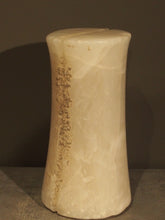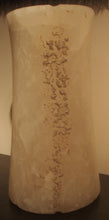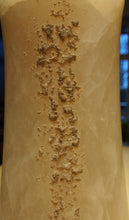
One of the most beautiful Bactrian (BMAC Period) miniature columns I ever had in my collection! Remark it’s very elegant shape, it’s tall size, it’s fantastic material: white alabaster, and it’s gloomy patina!
Bronze age Miniature Columns (sometimes called ‘Diminutive Columns’ and even ‘Column Idols’) have been found in a vast territory, stretching from the Karpates in the west up to West Siberia in the east , and all the way down to Baluchistan in the south!
They were either discovered in graves, either inside settlement areas. This means that apart from having a practical / most probably cult function they also must have had a function as prestige object or symbol of power.
The contexts in which these columns have been found during official excavations confirm a general dating to the second half of the 3rd millennium BC. If one keeps in mind that these columns were made some 4000 years ago, in a time when man had only hard stones as cutting tool and sand as abrasive material, one must deduct that making such a column costed so much time (and thus economic compensation) that a simple function (weight, or hanging stone) is out ruled.
Also, they were always made from specially selected stones: marbles, alabaster, travertine and steatite, often imported from far away regions.. The columns were always polished to enhance their polychromy. They could be cylindrical or tapering in contour, and bear a shallow groove on both flat ends (mostly, but not always aligned); this groove sometimes continued along the sides.
The miniature column here was made of a milky-white alabaster with grey inclusions, and has a shallow groove on top and base that continues along the sides. On one side it has a (calcium?) incrustation, the result of laying thousands of years buried under the ground. It belongs to the ‘Type B’ group according to Vidale’s hypothetical classification.
BMAC period (Bactria-Margiana Archaeological Complex), ca 2400-2200 BC. Excellent condition, nice gloomy patina. Minor chips off the top rim.
Height 31 cm; diameter top 13,5 cm; diameter base 16,5 cm. Weight 12,5 kilo.
Provenance: private German collection.
Price on Request
Further reading:
Massimo Vidale, Treasures from the Oxus, the Art and Civilization of Central Asia, London 2017, p.49.
V.I.Sarianidi, Un temple de Zoroastre au cœur du Karakoum, in Les Dossiers de l’Archéologie N° 185,1993, p.52
Marie-Hélène Pottier, Matériel Funéraire de la Bactriane Méridionale de L’Age du Bronze, Editions Recherche sur les Civilisations, Mémoire N°36, Paris 1984, p. 41-42 and p.216
Wiktor Sarianidi, Margus, Ancient Oriental Kingdom in the Old Delta of Murghab river, Ashgabat 2002, p.132-133
Margiana, Ein Königreich der Bronzezeit in Turkmenistan, Catalogue Berlin Neues Museum 2018, p 228-229








